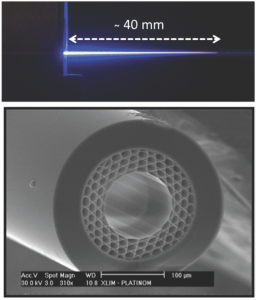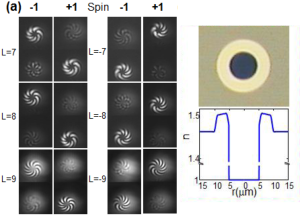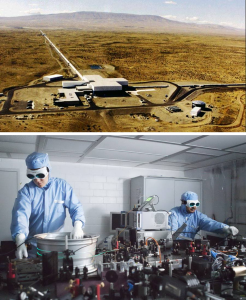By James Van Howe
 Top: Microplasma ignition in an argon-filled kagome-latticed hollow-core photonic crystal fiber. Bottom: scanning electron micrograph of fiber facet, from B. Dabord et al, CLEO 2013 talk, CTu3K.6, “Microconfinement of microwave plasma in photonic structures.” Microplasmas show promise for applications requiring small confinement of short-wavelength visible or UV light such as photolithography or compact UV laser emission sources.
Top: Microplasma ignition in an argon-filled kagome-latticed hollow-core photonic crystal fiber. Bottom: scanning electron micrograph of fiber facet, from B. Dabord et al, CLEO 2013 talk, CTu3K.6, “Microconfinement of microwave plasma in photonic structures.” Microplasmas show promise for applications requiring small confinement of short-wavelength visible or UV light such as photolithography or compact UV laser emission sources.
This post originally appeared on Jim’s Cleo Blog and is reproduced with the author’s permission.
Microwave plasmas, optical vortices, gravitational wave detection, and mode-division multiplexing for high-capacity telecom systems are just some of the topics in CLEO Science and Innovations 11: Fiber, Fiber Amplifiers, Lasers and Devices. I recently had an opportunity to speak with subcommittee chair, Siddharth Ramachandran from Boston University, U.S.A. to discuss this year’s program on fundamental fiber technology and devices. Though at a surface glance we may think fiber and fiber applications to be very conventional or already “all-figured out”, Ramachandran noted the fact that this subcommittee continues to receive so many submissions year-after-year (in fact the second largest in the entire conference for 2013) indicates that this is still an extremely active area of fundamental and applied research.
Ramachandran said that contributed and invited talks for the subcommittee could be divided into to two main categories: 1) Novel Fiber, and 2) Fiber Applications. The latter represents breakthroughs in engineering, instrumentation, and devices from fiber technology introduced five to fifteen years ago. It is the product of well-tended ideas, hard work, and ingenuity coming into fruition. The former, on the other hand, will likely be the seeds for cutting-edge instruments and systems five to fifteen CLEOs from now. In terms of novel fiber work, Ramachandran discussed two trends 1) Kagome-lattice structures, and 2) Mode-division multiplexing for high-capacity communications.
“We are still developing all sorts of novel fibers. What a fiber is, in terms of being a high-index region that guides light surrounded by a low-index region, is not a settled issue. There are actually a lot of innovations going on.”
Ramachandran spoke of how a decade back, the excitement in fiber research centered around photonic band gap fiber (PBG) which guides light in air (or a structure of silica/air-cores), but still provides many of the properties of standard single-mode fiber, particularly confinement and guidance over many kilometers of length. “That was very exciting, and then what happened afterwards is people found out these band-gap effects are nice for guiding light but they tend to have very small spectral regions where they can guide light, so it is not as universal as our old fibers.”
Kagome-lattice fibers, named for the trihexagonal pattern of air-holes resembling the weave-pattern of a Japanese Kagome basket, may provide one solution to having the versatility of air-guided fibers, while allowing large-bandwidth propagation.
“What Kagome lattice fibers essentially do is solve this spectrum-limiting problem we had with photonic band-gap fibers. You can get huge bandwidth out of these, albeit with slightly higher (theoretical) losses. And so they have been very interesting for doing nonlinear optics of gasses filled in these fibers, to do all sorts of dispersive applications where you need crazy high-bandwidth, and for instance to create plasmas. And then there are people who are trying to make ignition torches with fibers which one would never have thought of doing maybe even five years ago,” said Ramachandran.
 Left: Spiral interference pattern of twelve distinct orbital angular momentum states (vortex modes) after propagating through 2 m of the air-core fiber shown on the right. Right: photo of the facet of the core shown on top and index profile on the bottom. From P. Gregg et al, CLEO 2013 talk CTu2K.2, “Stable Transmission of 12 OAM States in Air-Core fiber.” The potential for simultaneous propagation of so many modes shows promise for mode-division multiplexing for high capacity telecom systems.
Left: Spiral interference pattern of twelve distinct orbital angular momentum states (vortex modes) after propagating through 2 m of the air-core fiber shown on the right. Right: photo of the facet of the core shown on top and index profile on the bottom. From P. Gregg et al, CLEO 2013 talk CTu2K.2, “Stable Transmission of 12 OAM States in Air-Core fiber.” The potential for simultaneous propagation of so many modes shows promise for mode-division multiplexing for high capacity telecom systems.
The other category for submissions on novel fiber development on this subcommittee has centered on mode-division multiplexing for high-capacity telecom systems. Ramachandran discussed,
“The simplest way to scale information capacity might be to not just use a single mode in a fiber, but to start using multiple modes. And that brings with it a lot of complexities of how different modes interact with each other and what impact dispersion has? What does the area of the fiber do, etcetera, etcetera? Which cycles back to being a fiber design and fiber fabrication problem. So there is a lot of innovation going on there. Even figuring out what modes one wants to send. Are they the standard modes that we have seen in textbooks? Or are they these more exotic orbital angular momentum or vortex modes?”
In addition to contributed submissions in these areas, four of the invited talks concern novel fibers and their propagation effects. On the other hand, the remaining invited talks, tutorial, and contributed submissions focus on fiber applications. The tutorial, by Michael Marhic of Swansea University, U.K. entitled “Fiber Optical Parametric Amplifiers in Optical communications,” will be given on Thursday June 13, from 2:00-3:00 pm. The invited talks in fiber applications, which are indicative of the contributed submissions, comprise topics as diverse as fiber parametric devices, microwave plasmas, gravitational wave detection, mid-IR sensing, and ultrafast laser combs.
 Top: Areal view of the Laser Intereferometer Gravitational-Wave Observatory (LIGO) at the Hanford Observatory site showing one of the 4 km arms. Photo from www.ligo.org image library. Bottom: One of the possible 3rd generation fiber-amplified laser sources for gravitational wave detection designed by Quest Centre for Quantum Engineering and Space-Time Research and Laser Zentrum Hannover e.V. Photo from Thomas Damm, Quest. Peter Wessels from Laser Zentrum Hannover e.V. will be describing many of the stringent requirements of laser sources used for gravitational wave detection such as high average power (~100 W to kW), single-frequency emission, ultra-low amplitude and phase noise, and diffraction-limited beam quality in CLEO 2013, invited talk, CW3M.5, “Single Frequency Laser Sources for Gravitational Wave detection.”
Top: Areal view of the Laser Intereferometer Gravitational-Wave Observatory (LIGO) at the Hanford Observatory site showing one of the 4 km arms. Photo from www.ligo.org image library. Bottom: One of the possible 3rd generation fiber-amplified laser sources for gravitational wave detection designed by Quest Centre for Quantum Engineering and Space-Time Research and Laser Zentrum Hannover e.V. Photo from Thomas Damm, Quest. Peter Wessels from Laser Zentrum Hannover e.V. will be describing many of the stringent requirements of laser sources used for gravitational wave detection such as high average power (~100 W to kW), single-frequency emission, ultra-low amplitude and phase noise, and diffraction-limited beam quality in CLEO 2013, invited talk, CW3M.5, “Single Frequency Laser Sources for Gravitational Wave detection.”
Ramachandran notes, “And the interesting thing about that space is the fiber itself that people are using is perhaps something that was developed anywhere between five years ago to maybe even fifteen years ago. We are now beginning to see all the promise that we initially thought that fibers could deliver and actually seeing applications across different disciplines of science and technology.”
Posted: 22 April 2013 by
James Van Howe
| with 0 comments